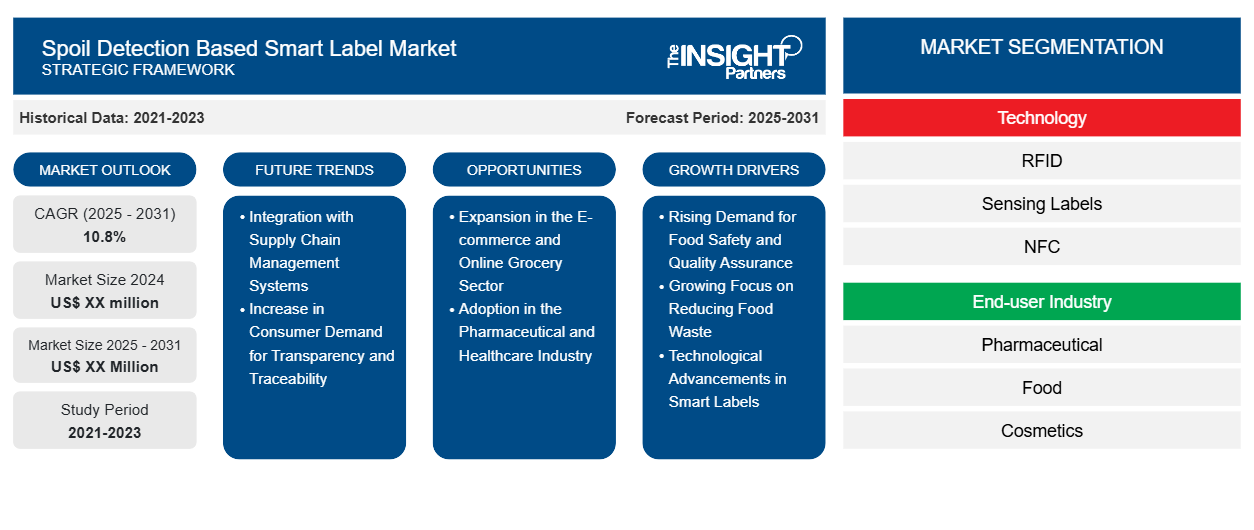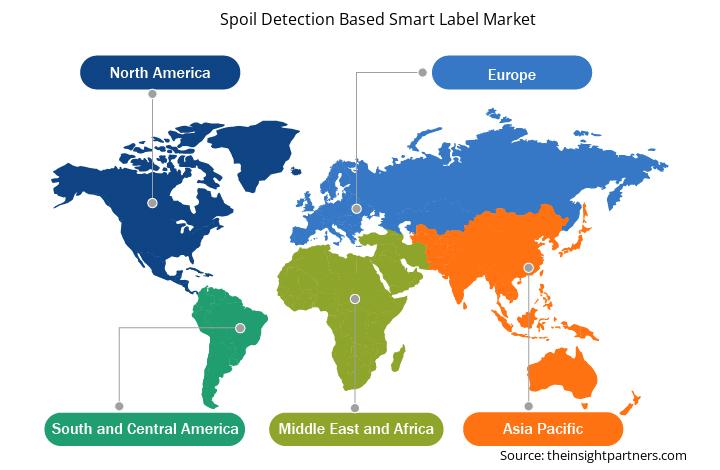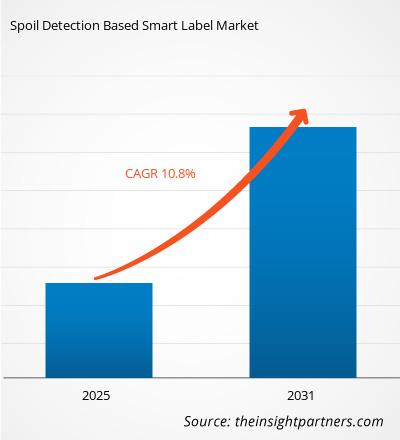预计基于废品检测的智能标签市场在 2025 年至 2031 年期间的复合年增长率为 10.8%,市场规模将从 2024 年的 XX 百万美元扩大到 2031 年的 XX 百万美元。
该报告按技术(RFID、传感标签和NFC)和最终用户行业(制药、食品、化妆品等)进行细分。全球分析进一步细分为区域和主要国家。报告以美元为单位,提供上述分析和细分市场的价值。
报告目的
Insight Partners 发布的《基于废料检测的智能标签市场》报告旨在描述当前市场格局和未来增长、主要驱动因素、挑战和机遇。这将为各业务利益相关者提供洞察,例如:
- 技术提供商/制造商:了解不断变化的市场动态并了解潜在的增长机会,使他们能够做出明智的战略决策。
- 投资者:对市场增长率、市场财务预测以及整个价值链中存在的机会进行全面的趋势分析。
- 监管机构:规范市场政策和警察活动,旨在最大限度地减少滥用行为,维护投资者的信任和信心,维护市场的完整性和稳定性。
基于损坏检测的智能标签市场细分
技术
- 射频识别
- 传感标签
- 近场通信
终端用户行业
- 制药
- 食物
- 化妆品
定制此报告以满足您的要求
您可以免费定制任何报告,包括本报告的部分内容、国家级分析、Excel 数据包,以及为初创企业和大学提供优惠和折扣
基于损坏检测的智能标签市场:战略洞察

- 获取此报告的顶级关键市场趋势。此免费样品将包括数据分析,从市场趋势到估计和预测。
基于损坏检测的智能标签市场增长动力
- 食品安全和质量保证需求不断增长:随着人们对食品安全和质量的日益关注,基于腐败检测的智能标签在食品和饮料行业中变得至关重要。这些标签通过实时检测腐败情况,有助于监控易腐食品的新鲜度和质量。这一趋势源于消费者对食源性疾病、食品召回以及确保食品安全(尤其是乳制品、肉类和海鲜等敏感食品)需求的提升。随着食品安全法规的日益严格,腐败检测技术的需求预计将持续增长。foodborne illnesses, food recalls, and the need to ensure the safety of food products, particularly for sensitive items like dairy, meat, and seafood. As regulations around food safety tighten, the demand for spoil detection technology is expected to rise.
- 减少食物浪费日益受到重视:食物浪费是一个全球性重大问题,基于变质检测的智能标签通过提供准确、实时的产品新鲜度信息,在减少浪费方面发挥着关键作用。这些标签使消费者、零售商和分销商能够更好地了解易腐烂商品的状况,并做出明智的决定,决定是否应丢弃、消费或进一步加工。供应链中减少食物浪费的需求日益增长,推动了变质检测技术的应用。
- 智能标签的技术进步:材料科学、传感器和物联网连接领域的持续创新,推动了更先进、更经济高效的基于废品检测的智能标签的开发。这些标签现在可以与数字平台集成,为整个供应链中的利益相关者提供实时数据和警报。随着该技术日益成熟、价格合理且易于获取,其在食品、制药和化妆品等各个行业的应用正在加速,从而推动市场增长。
基于损坏检测的智能标签市场未来趋势
- 与供应链管理系统集成:基于损坏检测的智能标签市场的一个日益增长的趋势是将这些标签与更广泛的供应链管理系统集成。通过将损坏检测标签与库存和物流管理系统连接,企业可以跟踪整个供应链中货物的新鲜度和状态。这种集成有助于优化存储条件,确保产品在正确的温度下运输,并减少运输过程中的损坏,从而提高运营效率并减少损失。
- 消费者对透明度和可追溯性的需求日益增长:食品生产和可追溯性的透明度趋势日益增强,这得益于消费者对所购产品更多信息的需求。基于变质检测的智能标签为消费者提供产品新鲜度和质量的实时数据,从而进一步提升透明度,增强消费者的信心。这一趋势在有机食品、高端商品以及注重健康的消费者群体中尤为重要,他们重视所购商品的质量和安全详细信息。
基于损坏检测的智能标签市场机会
- 电子商务和在线杂货行业的扩张:在线杂货购物和电子商务的增长为基于变质检测的智能标签带来了巨大的机遇。随着直接面向消费者的配送业务的兴起,确保易腐烂产品在运输过程中保持其质量和新鲜度至关重要。智能标签可以帮助消费者追踪已送达货物的新鲜度,并确保产品质量。在电子商务平台寻求创新解决方案以应对易腐烂物品运输挑战之际,这一机遇尤为重要。
- 制药和医疗保健行业应用:基于变质检测的智能标签主要用于食品行业,但在制药和医疗保健行业也展现出巨大的潜力。许多药品,例如疫苗、生物制剂和对温度敏感的药物,需要严格的环境控制才能保持其功效。智能标签可以提供有关温度波动、变质或产品降解的关键信息,为敏感的医疗保健产品提供更高水平的保护,并有助于确保患者安全。这代表着基于变质检测的智能标签尚未开发的市场。
基于损坏检测的智能标签市场区域洞察
Insight Partners 的分析师已详尽阐述了预测期内基于废品检测的智能标签市场的区域趋势和影响因素。本节还讨论了基于废品检测的智能标签市场在北美、欧洲、亚太地区、中东和非洲以及南美和中美洲的细分市场和地域分布。

- 获取基于废料检测的智能标签市场的区域特定数据
基于损坏检测的智能标签市场报告范围
| 报告属性 | 细节 |
|---|---|
| 2024年的市场规模 | XX百万美元 |
| 2031年的市场规模 | XX百万美元 |
| 全球复合年增长率(2025-2031) | 10.8% |
| 史料 | 2021-2023 |
| 预测期 | 2025-2031 |
| 涵盖的领域 | 按技术
|
| 覆盖地区和国家 | 北美
|
| 市场领导者和主要公司简介 |
|
基于损坏检测的智能标签市场参与者密度:了解其对业务动态的影响
基于污渍检测的智能标签市场正在快速增长,这得益于终端用户需求的不断增长,而这些需求的驱动因素包括消费者偏好的演变、技术进步以及对产品优势的认知度的提升。随着需求的增长,企业正在扩展产品线,不断创新以满足消费者需求,并抓住新兴趋势,从而进一步推动市场增长。
市场参与者密度是指特定市场或行业内企业或公司的分布情况。它表明特定市场空间内竞争对手(市场参与者)的数量相对于其规模或总市值而言。
在基于废料检测的智能标签市场运营的主要公司有:
- 思迈创科科技集团
- 薄膜电子ASA
- 艾利丹尼森
- 斑马技术
- 应用油墨解决方案
免责声明:以上列出的公司没有按照任何特定顺序排列。

- 获取基于损坏检测的智能标签市场顶级关键参与者概述
主要卖点
- 全面覆盖:该报告全面涵盖了基于废料检测的智能标签市场的产品、服务、类型和最终用户的分析,提供了整体概况。
- 专家分析:本报告基于对行业专家和分析师的深入了解而编写。
- 最新信息:该报告涵盖了最新信息和数据趋势,确保了业务相关性。
- 定制选项:此报告可以定制以满足特定客户要求并适合业务策略。
因此,这份关于基于废料检测的智能标签市场的研究报告,有助于引领解读和理解行业现状及增长前景。尽管存在一些合理的担忧,但本报告的总体利大于弊。
- 历史分析(2 年)、基准年、预测(7 年)及复合年增长率
- PEST和SWOT分析
- 市场规模、价值/数量 - 全球、区域、国家
- 行业和竞争格局
- Excel 数据集
近期报告
相关报告
客户评价
购买理由
- 明智的决策
- 了解市场动态
- 竞争分析
- 客户洞察
- 市场预测
- 风险规避
- 战略规划
- 投资论证
- 识别新兴市场
- 优化营销策略
- 提升运营效率
- 顺应监管趋势




















 获取免费样品 - 基于损坏检测的智能标签市场
获取免费样品 - 基于损坏检测的智能标签市场